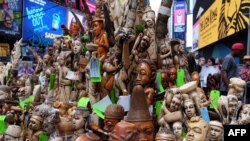More than one ton of illegal ivory was crushed in New York City’s Times Square on June 19. The U.S. Fish and Wildlife Service sponsored the event. The goal was to raise awareness about the ongoing plight of elephants, especially in Africa where as many as 35,000 are poached every year.
The African Wildlife Foundation, the largest conservation organization focused exclusively on the continent, lent its full support to the ivory crush in New York.
AWF officials said Times Square is one of the most recognizable and iconic intersections of the world, and by destroying the ivory there, the United States is giving the elephant crisis the kind of global spotlight it deserves.
The AWF’s program director, Jimmiel Mandima, attended the event.
“The message this crush is meant to send,” he said, “is to say no to ivory trades-- for now-- until we are satisfied many years from now--nobody should trade and sell ivory. Crushing is simply saying it has no commercial value.”
He said the destruction of the ivory in New York will show the world that the US is taking strong action against poaching and the illegal trade of ivory. In addition, the US Congress is considering several bills to ban the sale of ivory and stop poaching.
“In this type of crisis, it always requires a global and respected leader to show by example that it’s actually taking action seriously. As we see all of these bills being propagated, and the US government publicly declaring that they are not accepting ivory as part of a commercial commodity, it sends a very strong message to all other parties,” asserted Mandima.
“What it implies is for anybody who is contemplating continuing to poach on the African continent,” he continued, “they have to think twice…because where does it go? Who buys it, because it can’t enter the market anymore.”
He said the fight against poaching is making progress. He cited, for example, the increasing number of countries around the world taking action throughout the various stages of the supply chain, including the trafficking of and demand for ivory. And he said poachers on elephant range sights are taking more caution in their illegal activities.
“It’s a coordination of different variables and different actions that all add up to what can be done to reduce poaching,” said Mandima.










